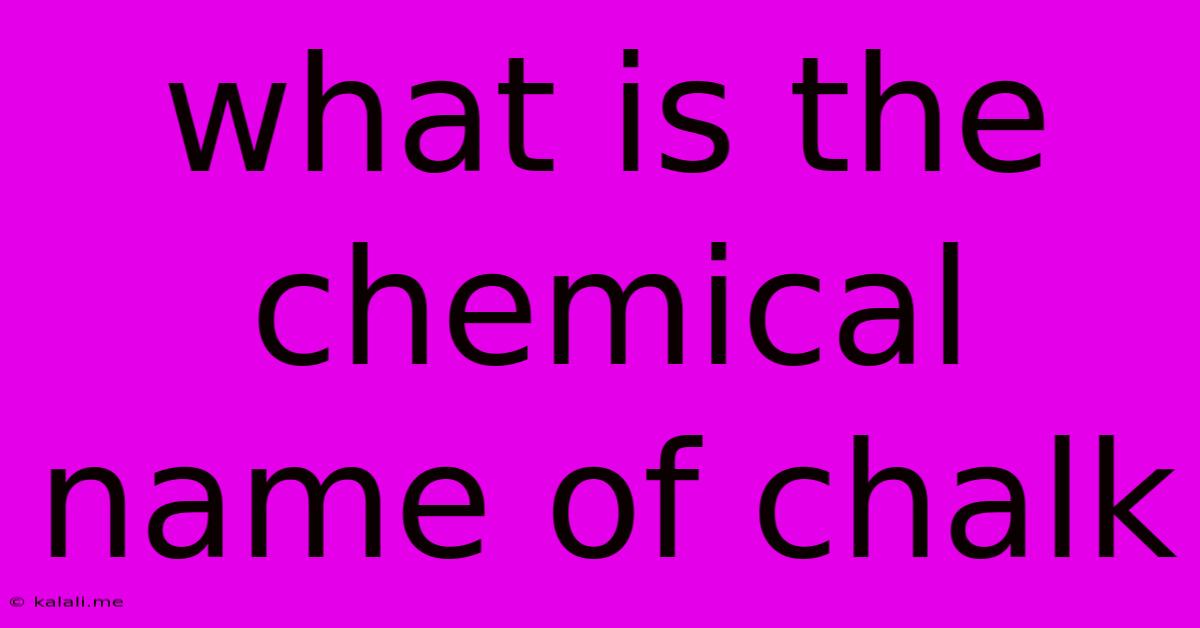What Is The Chemical Name Of Chalk
Kalali
Jun 13, 2025 · 3 min read

Table of Contents
What is the Chemical Name of Chalk? Unlocking the Secrets of Calcium Carbonate
Chalk, that familiar white substance used on blackboards, in classrooms, and even in some dietary supplements, is more than just a simple writing tool. Understanding its chemical makeup reveals a fascinating world of minerals and their applications. This article dives into the chemical name of chalk and explores its properties and uses.
What is Chalk? More Than Just a Blackboard Tool
Before revealing the chemical name, let's establish what chalk actually is. Chalk is a soft, white, porous sedimentary carbonate rock, composed mainly of the skeletal remains of microscopic marine organisms such as coccoliths. These organisms secrete calcium carbonate, which accumulates over millions of years to form thick chalk deposits. This accumulation process gives chalk its unique texture and composition.
The Chemical Name: Calcium Carbonate
The main component of chalk is calcium carbonate, also known as CaCO3. This chemical formula indicates that each molecule of calcium carbonate consists of one calcium atom (Ca), one carbon atom (C), and three oxygen atoms (O). This simple yet powerful compound is responsible for many of chalk's properties, including its softness and its reaction with acids.
Understanding the Properties of Calcium Carbonate in Chalk
The properties of calcium carbonate directly influence the characteristics of chalk. Its relatively soft nature (on the Mohs hardness scale, it scores around 3) makes it easy to write with and leaves a distinct mark on surfaces. Its porous structure allows it to absorb moisture, influencing its use in various applications. The reaction with acids, producing carbon dioxide gas, explains its use in certain scientific experiments and industrial processes.
Beyond the Blackboard: Diverse Applications of Calcium Carbonate
While chalk's most familiar use is as a writing tool, its applications extend far beyond the classroom. Calcium carbonate finds use in various industries, including:
- Dietary Supplements: Calcium carbonate is a common source of dietary calcium, essential for bone health and overall well-being.
- Construction: It is used as a filler in paints, plastics, and other materials.
- Agriculture: It's utilized to improve soil conditions and increase its pH level.
- Paper Manufacturing: It acts as a coating agent in paper production.
- Pharmaceuticals: It serves as a filler in tablets and capsules.
Exploring Related Compounds and Minerals
Calcium carbonate is closely related to other minerals and compounds, including limestone and marble, both of which are also primarily composed of calcium carbonate but differ in their formation and crystalline structure. Understanding these relationships provides a more comprehensive understanding of the geological context of chalk formation.
Conclusion: A Simple Compound with Broad Implications
While the chemical name of chalk might seem simple – calcium carbonate (CaCO3) – its significance extends far beyond its basic formula. From its formation in ancient oceans to its widespread use in various industries, chalk serves as a testament to the fascinating properties of naturally occurring minerals and their importance in our daily lives. This understanding of its chemical composition provides a deeper appreciation for this seemingly humble substance.
Latest Posts
Latest Posts
-
Difference Between Pcr And Dna Replication
Jun 14, 2025
-
Which Of The Following Is Not True About Voip
Jun 14, 2025
-
What Is The Opposite Of Advocate
Jun 14, 2025
-
What State Of Matter Has The Most Kinetic Energy
Jun 14, 2025
-
An Oxygen Atom Has How Many Valence Electrons
Jun 14, 2025
Related Post
Thank you for visiting our website which covers about What Is The Chemical Name Of Chalk . We hope the information provided has been useful to you. Feel free to contact us if you have any questions or need further assistance. See you next time and don't miss to bookmark.